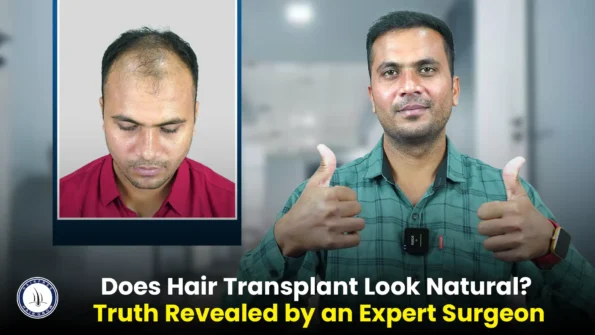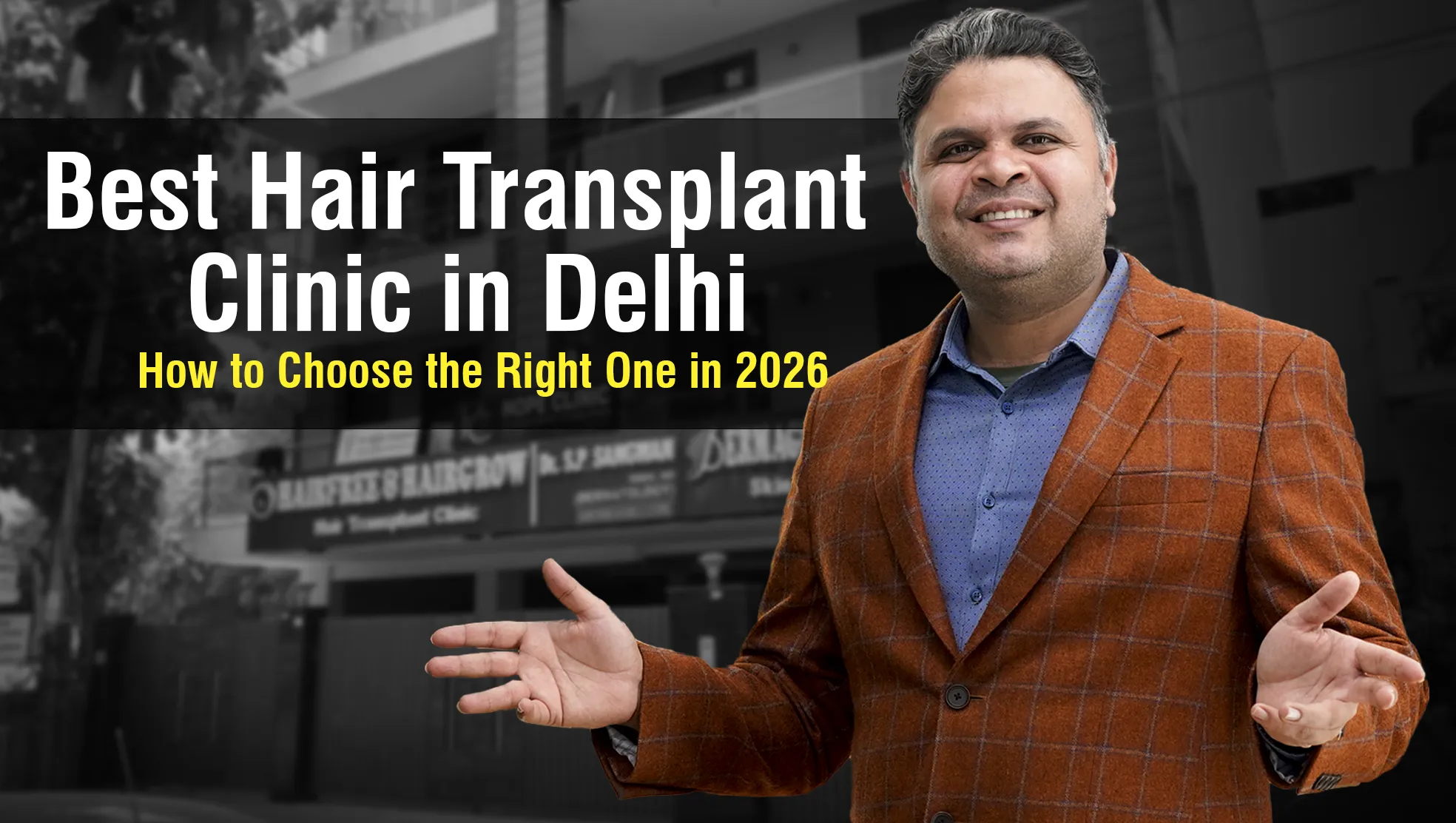Yes, hair transplants can look very natural, especially with modern techniques and skilled surgeons.
Imagine meeting an old friend after years. They stare at you for a moment, puzzled “You look younger… Did you do something different?” You smile and change the topic. That’s when you know your hair transplant worked perfectly.
Because the best hair transplants are the ones no one can notice.
In today’s world, where appearance and confidence go hand in hand, hair restoration has become a game-changer. But with it comes the biggest concern people have:
“Will it look fake?”
“Will people know I had surgery?”
The good news? With modern techniques and experienced hands, hair transplants today can look incredibly real, seamless, and 100% natural.
In this blog, we’ll uncover does hair transplants look natural and the top reasons why some hair transplants are undetectable. You’ll learn what makes the difference, straight from expert insights and trusted practices.
Let’s dive into the real truth behind natural-looking hair transplants.
Do Hair Transplants Look Natural in 2025?
Yes, modern hair transplants can look extremely natural—when done correctly. Thanks to advanced techniques like FUE (Follicular Unit Extraction)↗️ and the expertise of experienced surgeons, hair transplant results today are a far cry from the unnatural “pluggy” look seen in the 70s or 90s.
In the past, due to limited technology and improper techniques, transplants often looked obvious. But now, with refined methods, precision tools, and customized hairline design, people often can’t tell you’ve had a procedure at all.
Top 10 Factors That Affect Natural Hair Transplant Results
1. Surgical Technique Used
The method your surgeon uses plays a crucial role in how natural your hair transplant looks.
- FUE (Follicular Unit Extraction) is a popular, minimally invasive technique where individual grafts are extracted and implanted. It leaves no visible scarring and offers more natural-looking results↗️.
- FUT (Follicular Unit Transplantation) involves removing a strip of scalp from the donor area. It may leave a linear scar, especially visible for those who wear short hair.
2. Skill and Experience of the Surgeon
- Understands hair growth patterns
- Knows how to implant hair at the right angle and direction
- Can ensure seamless blending between transplanted and native hair
3. Angle and Direction of Hair Implantation
Hair must be implanted in a natural angle and direction to match existing hair growth. If this is not done correctly, the results will appear awkward or artificial.
Think of your natural hair growth—it’s never straight or uniform. Skilled surgeons recreate this irregularity with precision.
4. Customized Hairline Design
A natural hairline is not a straight line. It should be “irregularly regular”, meaning it mimics natural growth patterns and fits the patient’s facial structure.
A hairline that’s too low or too symmetrical can look fake. A good surgeon takes your age, face shape, and aesthetic goals into account.
5. Optimum Graft Density
If the hair is too sparse, it won’t look natural. If it’s too dense in the wrong areas, it may look unnatural or pluggy. The key is balanced density, especially in the frontal hairline zone.
- Single hair grafts are used at the hairline for softness
- Multiple hair follicle units are used behind for volume
6. Proper Graft Placement
Placing the right type of grafts in the right zone is essential. For example, only single-hair grafts should be used on the hairline to avoid a fake or chunky appearance.
7. Maintaining a Natural Hairline Shape
Avoid straight, flat hairlines. Instead, go for a slightly uneven shape that mimics natural aging. A poorly designed hairline can be a dead giveaway.
Also, positioning matters:
- Too low = Unnatural for your age
- Too high = Makes forehead look larger than natural
8. Even Graft Extraction from Donor Area
If hair is not extracted uniformly, the donor area (usually the back of the scalp) may appear patchy or over-harvested.
Expert surgeons rotate and space out extractions to maintain donor site aesthetics.
9. Sufficient Donor Area Availability
- Graft strength
- Hair thickness
- Scalp condition
10. Tools and Technology Used in Clinic
State-of-the-art clinics like Hairfree Hairgrow India use US-made precision punches and high-magnification tools that allow:
- Better graft handling
- Less trauma during extraction and placement
- Almost invisible scarring
At Hairfree & Hairgrow Clinic↗️, we specialize in natural-looking hair transplants that are virtually undetectable. With over a decade of expertise, advanced FUE techniques, and personalized treatment plans, we help you restore not just your hair—but your confidence.
- Expert Surgeons
- Customized Hairline Design
- Painless Procedure, Natural Results
Book your FREE consultation now and see why thousands trust Hairfree & Hairgrow for their hair transformation.
Final Thought: Does Hair Transplant Look Natural?
Yes, modern hair transplants can look extremely natural—when done correctly. Thanks to advanced techniques like FUE (Follicular Unit Extraction) and the expertise of experienced surgeons, hair transplant results today are a far cry from the unnatural “pluggy” look seen in the 70s or 90s.
In the past, due to limited technology and improper techniques, transplants often looked obvious. But now, with refined methods, precision tools, and customized hairline design, people often can’t tell you’ve had a procedure at all.
FAQs
1. Will people be able to tell if I had a hair transplant?
Not if it’s done correctly. A well-performed hair transplant using advanced techniques like FUE and proper hairline design by an experienced surgeon will look completely natural. Most people won’t notice unless you tell them.
2. Which technique gives the most natural-looking results—FUE or FUT?
FUE (Follicular Unit Extraction) is generally considered to provide more natural results. It involves minimal scarring, precise graft placement, and better blending with existing hair compared to FUT, which may leave a visible scar.
3. How important is the hairline design for natural results?
Very important. The hairline should match your facial structure, age, and natural growth pattern. A poorly designed hairline—too straight or too low—can make the transplant look fake.
4. Does the donor area look patchy after the transplant?
It shouldn’t—if grafts are extracted evenly and the surgeon uses the right tools. Uneven or overharvesting can cause visible thinning, but expert clinics ensure uniform graft extraction to maintain a natural look.
5. How long does it take for a hair transplant to look natural?
Usually around 9 to 12 months. Initial shedding occurs after the surgery, followed by gradual hair regrowth. By the end of the first year, your transplanted hair blends naturally with your existing hair.
Written By
MBBS, DDV
Dr. Shridevi Lakhe emphasizes that achieving natural-looking hair transplants depends on several crucial factors. She highlights the importance of skilled surgeons proficient in advanced FUE techniques, meticulous hairline design that mimics natural growth, and optimal graft placement.
Disclaimer
We’ve made all possible efforts to ensure that the information provided here is accurate, up-to-date and complete, however, it should not be treated as a substitute for professional medical advice, diagnosis or treatment. See Detailed Disclaimers Here.



